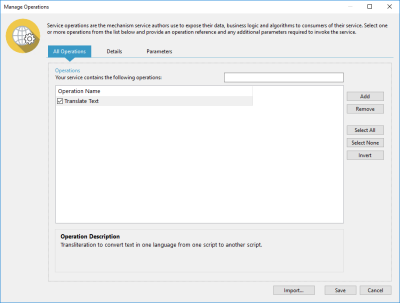An Operation is the actual mechanism used to send requests to a service. In turn, the way an operation is configured determines what action is performed when a service is called and what the provider returns.
Every different action a service offers will be represented by a unique operation. For example, a translation service could include two different operations for performing spell checks and proof reading, respectively.
To create a new operation, it will require certain Parameters to work, which determine what data or functionality is requested from the service. These will usually be supplied by the provider via documentation. However, if you use an OpenAPI document to create the service, the necessary operation parameters will be added at the same time.
Each parameter must also be configured with a compatible value, which can be either a default value or a KnowledgeKube keyword. If both are supplied, and the keyword contains a value, it will override the default.
Operations can be added when you create a new service but also later. In addition, they can be created manually, or by importing an OpenAPI document. Regardless of which method you use, the interface for managing operations is the same.
To learn how to create and manage operations, refer to the following topics:
| Description | Further Reading |
|---|---|
| Add new operations to a service manually. | Creating an Operation for an Existing Service |
| Import operations into an existing service using an OpenAPI document. | Creating Operations By Importing an OpenAPI Document |
| Modify an existing operation. | Editing an Operation |
| Change the current status of an operation. | Enabling and Disabling Operations |
| Deleting or disabling operations. | Deleting an Operation |
| Testing an operation. | Testing an Operation |

